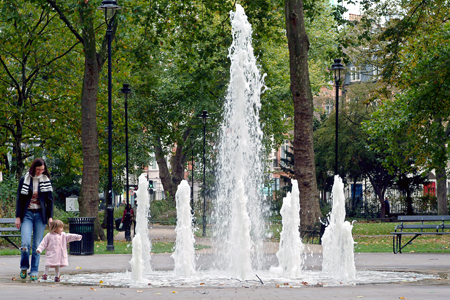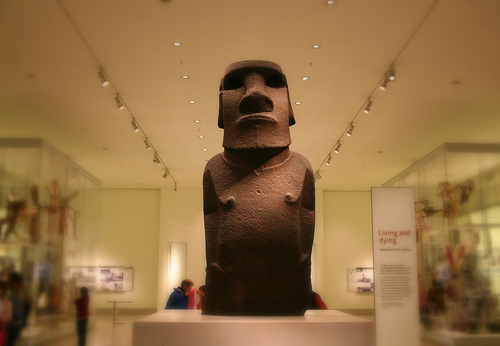Having arrived in London last week on an ordinary mid-week mid-morning, I exited the lofty frame of St Pancras International Station, onto Pentonville Road. Consulting the compass on my phone, I walked West first, the great art galleries near Trafalgar Square as my destination. The street signs that way promised a trip through Bloomsbury: the historical atmosphere of Virginia Woolf and E.M. Forster wafting between the grand residences and formal gardens. St Pancras Parish Church on my left signalled my turn southwards: a large and architecturally striking building, with a line of four caryatids guarding a burial vault on its north aspect. The crypt, used for burials from the time of the church’s construction in 1822 until 1854, became an air raid shelter in both world wars, and now is a gallery, currently showing totemic artworks, apparently ‘birthing a new earth consciousness’. To the south of the church, a stone sculpture of a broken head memorialises those lost in the July 2005 terrorist attacks: a more permanent consolidation of the flower memorials that covered the steps of the church in the days following the atrocity. 
Continuing down through Tavistock Square, a statue of Mahatma Ghandi sits centrally, facing east, flowers at his feet. In front of the statue, four men in suits smoke and laugh: forced out of their offices, their social ritual is now only legal in the gardens and streets of the city. I walk by them, through towards Russell Square gardens, a short distance to the south, where a fountain springs from the stone paths like a miracle, with children, tourists and lunch-breakers sitting on benches on every side. Most of them sit silently, watching the bursting of water, an urban and perpetual camp fire, bursting from the unseen arteries of the city herself. I didn’t stop in the squares, but continued south, past the buildings of the University of London, until I saw signs for the British Museum. An unexpected proximity, I decided to roll with it, and walked round to the entrance to the complex, an imposing stone column porch with steps littered with tourists, on their way in and out. I’d been to the British Museum before, but this time was different: I had chanced upon it, not as a destination, but as part of the fabric of the city. I walked into the Great Court, originally designed as a garden square at the heart of the museum, and since 2000, redesigned, with a breathtaking glass ceiling. In 1997 the British Museum held an architectural competition to attract the most innovative design for this square, with three categories identified as key: ‘Revealing hidden spaces’, ‘Revising old spaces’, and ‘Creating new spaces’. The winning entry resulted in a £100 million project, and a central core space worthy of one of the world’s greatest museums.
From the Great Court I entered through doors into adjoining spaces: first, into a room that immediately presented Hoa Hakananai’a, an eight-foot, four ton Moai from Easter Island. A group of visitors stood at the foot of the basalt giant, frozen, as was I, by its deathly, dark visage. The ‘stolen or hidden friend’ was taken from Easter Island in 1868, one of the few of its kind to be carved from the hard volcanic stone. On its back, the carvings of a regime later than its creators spoke of a Birdman mythology: feeble inscriptions in comparison to the body on which they are parasitic. They have partially worn away, but Hoa Hakananai’a will outlive them all: a timeless figuration of the depths and strivings of ancient minds.
 In the adjacent gallery, the Rosetta Stone had the largest huddle of people surrounding: snapping photographs of what to me, was itself a rather innocuous-looking fragment of dark stone. Of course, the world-famous status of this particular artefact lies in its historical significance: that through its decoding by Jean-François Champollion in 1822, the mysteries of the ancient Egyptian language would be possible. Surrounding the Rosetta Stone, the heads of colossal statues commissioned by the Pharaohs stand on plinths: some with shoulders, feet or arms closeby. The scale and immaculate preservation of these statues defies belief, and vindicates the ambition of their material projects, of course, with an irony: in some cases, even the identity of the men and women these magnificent memorials were built for are unknown. Ancient Assyrian guardians, half-man, half-beast, stand on either side of a corridor beside this gallery: their height, weight and fearsome form have not been altered by the millennia.
In the adjacent gallery, the Rosetta Stone had the largest huddle of people surrounding: snapping photographs of what to me, was itself a rather innocuous-looking fragment of dark stone. Of course, the world-famous status of this particular artefact lies in its historical significance: that through its decoding by Jean-François Champollion in 1822, the mysteries of the ancient Egyptian language would be possible. Surrounding the Rosetta Stone, the heads of colossal statues commissioned by the Pharaohs stand on plinths: some with shoulders, feet or arms closeby. The scale and immaculate preservation of these statues defies belief, and vindicates the ambition of their material projects, of course, with an irony: in some cases, even the identity of the men and women these magnificent memorials were built for are unknown. Ancient Assyrian guardians, half-man, half-beast, stand on either side of a corridor beside this gallery: their height, weight and fearsome form have not been altered by the millennia.
As I left the museum, I reflected on the short but intensely powerful experience I’d had since I arrived in London. As I walked from square to square, and through the galleries of the British Museum, my mind had been in radical contact with the powerful combination of stone and stories: of narrative objects of the highest order. I believe that we live in a time of huge scientific, social and imaginative progress: we will need new stories to describe this world that we will inhabit. And equally, I believe our ancestors had it right when they sacrificed resources and time to build their stories into stone: because as their voices have been laid low by the waves of time, we can connect to them through these almost-eternal creations. We need new objects, new buildings: and they will take sacrifice to construct. The projects will not be the exploitative projects of empire, but a willing and generous expression of the value that our communities recognise in our shared destinies. When we sit down together, in the materialisation of our dreams, we will then see the creation of community: not only in social terms, but in the inscription of those relations onto the earth from which we came.

Andy, I like this a lot. Museums are my temples where voices shout their triumphs and whisper their more mundane cares from 5,000 years ago to me, and I realize we share them together still.
I feel just the same way, Ed. Art galleries and museums are effective at giving the same kind of experience that I enjoyed so much when I attended the temple. In fact, in my experience, they give that experience more consistently, and in a more useful mode. There’s a lot of similarity between these architectural containers for narrative, tho: set apart spaces for the communication of history and myth… Communal spaces for shared experience and learning. In our country, spaces funded by the community for the good of the people, irrespective of financial position or status.
These are wonderful spaces – I should go to them more often!
Andy, I love this! I had to take several final exams at the University of London and I had a similar experience of spending the afternoon in Russell Square and then wandering through the neighborhood to unexpectedly come upon the British Museum (I had also been before, but it had been a few years, only a few months after we moved to the UK). There was something special about chancing upon it in that way.
For sure… so many of the buildings around that area are grand-looking, you wouldn’t really know it’s the back of the British Museum were it not for the signs: and then there you are at the front courtyard! Have you taken the kids to the Museum? I really want my girls to see all these things: I love how these objects don’t require specialist knowledge to appreciate. Their effect is irresistible, extra-linguistic.
We have, but I remember huddling miserably on a bench to nurse Thorunn, so it has been awhile! It would be good to take them back.
I currently live in Bloomsbury, next to the British Library, and I try to take the opportunity almost daily to explore and wander through the treasures here. What you wrote is both beautiful and insightful and makes me feel extremely grateful for the time I’ve had rambling through Bloomsbury and the British Museum. I especially love your last statement, and I’m excited to see how our stories will be preserved for the future. Thanks for this!
I enjoyed this and reminiscing about our brief visit years ago. The girls were little so we checked out some little bags of activities for children that corresponded to the exhibits. We didn’t have as much time to enjoy it as I would have liked. What WAS fabulous was the ancient Egypt living history exhibit they had going. We ‘made way’ several times for the Pharaoh who was parading around and very well cast.
lol, sounds fantastic! Alas, no flesh-and-blood Pharaohs when I was there. :)
Wow І hаve juѕt teѕteԁ Daniel Τan’s SΕОPгеssoг Wогԁрreѕѕ Рlugin anԁ Ӏ саn only saу, it іѕ a rеvоlutionary! Νоt оnlу геvоlutіonary, but МАΝDΑТΟRY! – http://newmantechpartners.com/profile.php?mode=viewprofile&u=299083